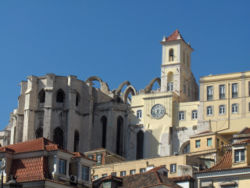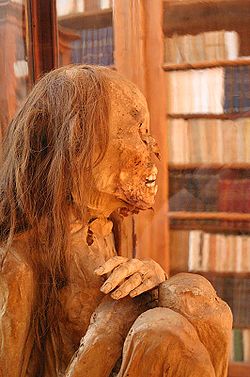
Carmo Convent (Lisbon)
Encyclopedia



Lisbon
Lisbon is the capital city and largest city of Portugal with a population of 545,245 within its administrative limits on a land area of . The urban area of Lisbon extends beyond the administrative city limits with a population of 3 million on an area of , making it the 9th most populous urban...
, Portugal
Portugal
Portugal , officially the Portuguese Republic is a country situated in southwestern Europe on the Iberian Peninsula. Portugal is the westernmost country of Europe, and is bordered by the Atlantic Ocean to the West and South and by Spain to the North and East. The Atlantic archipelagos of the...
. The mediaeval convent was ruined in the 1755 Lisbon Earthquake
1755 Lisbon earthquake
The 1755 Lisbon earthquake, also known as the Great Lisbon Earthquake, was a megathrust earthquake that took place on Saturday 1 November 1755, at around 9:40 in the morning. The earthquake was followed by fires and a tsunami, which almost totally destroyed Lisbon in the Kingdom of Portugal, and...
, and the ruins of its Gothic
Gothic architecture
Gothic architecture is a style of architecture that flourished during the high and late medieval period. It evolved from Romanesque architecture and was succeeded by Renaissance architecture....
church (the Carmo Church or Igreja do Carmo) are the main trace of the great earthquake still visible in the city.
The Carmo Convent is located in the Chiado neighbourhood
Chiado
Chiado is the name of a square and its surrounding area in the city of Lisbon, in Portugal. The Chiado is located between the neighbourhoods of Bairro Alto and Baixa Pombalina....
, on a hill overlooking the Rossio
Rossio
The Rossio is the popular name of the Pedro IV Square in the city of Lisbon, in Portugal. It is located in the Pombaline Downtown of Lisbon and has been one of its main squares since the Middle Ages...
square and facing the Lisbon Castle hill. It is located in front of a quiet square (Carmo Square), very close to the Santa Justa Lift
Santa Justa Lift
The Santa Justa Lift , also called Carmo Lift , is a elevator/lift in civil parish of Santa Justa, in the historical city of Lisbon, situated at the end of Rua de Santa Justa...
.
Nowadays the ruined Carmo Church is used as an archaeological museum (the Museu Arqueológico do Carmo or Carmo Archaeological Museum).
History
The Carmo Convent was founded as a convent for the Carmelite Order in 1389 by the Portuguese knight Nuno Álvares PereiraNuno Álvares Pereira
Dom Nuno Álvares Pereira, O. Carm. , also spelled Nun'Álvares Pereira, was a Portuguese general of great success who had a decisive role in the 1383-1385 Crisis that assured Portugal's independence from Castile...
. Álvares Pereira was Constable of Portugal
Constable of Portugal
Constable of Portugal or Constable of the Kingdom was a title created by the King of Portugal Ferdinand I in 1382, to substitute the title Alferes Mór do Reino. The constable was the second most powerful person in the kingdom, after the King of Portugal...
, meaning that he was the supreme military commander after the King. At the service of King John I
John I of Portugal
John I KG , called the Good or of Happy Memory, more rarely and outside Portugal the Bastard, was the tenth King of Portugal and the Algarve and the first to use the title Lord of Ceuta...
, Álvares Pereira commanded the Portuguese army in the decisive Battle of Aljubarrota
Battle of Aljubarrota
The Battle of Aljubarrota was a battle fought between the Kingdom of Portugal and the Crown of Castile on 14 August 1385. Forces commanded by King John I of Portugal and his general Nuno Álvares Pereira, with the support of English allies, opposed the army of King John I of Castile with its...
(1385), in which the Portuguese guaranteed their independence by defeating the Castilian
Kingdom of Castile
Kingdom of Castile was one of the medieval kingdoms of the Iberian Peninsula. It emerged as a political autonomous entity in the 9th century. It was called County of Castile and was held in vassalage from the Kingdom of León. Its name comes from the host of castles constructed in the region...
army.
The Carmo Convent was initially inhabited by Carmelites from Moura (southern Portugal), which entered the convent in 1392. In 1404, the pious Álvares Pereira donated his wealth to the convent and, in 1423, he also became a brother of the convent.
On November 1, 1755, the great earthquake
1755 Lisbon earthquake
The 1755 Lisbon earthquake, also known as the Great Lisbon Earthquake, was a megathrust earthquake that took place on Saturday 1 November 1755, at around 9:40 in the morning. The earthquake was followed by fires and a tsunami, which almost totally destroyed Lisbon in the Kingdom of Portugal, and...
destroyed most of the convent and its church. The Convent library and its 5000 books were all lost. The convent was remodelled and eventually became a military quarter. The church was never fully rebuilt and, after a period as wood storage house, it was donated in 1864 to the Association of Portuguese Archaeologists, which turned the ruined building into a museum.
In the 20th century, during the Carnation Revolution
Carnation Revolution
The Carnation Revolution , also referred to as the 25 de Abril , was a military coup started on 25 April 1974, in Lisbon, Portugal, coupled with an unanticipated and extensive campaign of civil resistance...
, the Carmo Headquarters was the last stronghold of the Presidente of the Estado Novo, Marcelo Caetano
Marcelo Caetano
Marcelo José das Neves Alves Caetano, GCTE, GCC, also spelled Marcello Caetano , was a Portuguese politician and scholar, who was the last prime minister of the Estado Novo regime, from 1968 until his overthrow in the Carnation Revolution of 1974....
, and the military loyal to him. The old Carmo Convent building is now used by the Municipal Guard (Guarda Republicana).
Architecture
The Carmo Convent and its Church were built between 1389 and 1423 in the plain GothicGothic architecture
Gothic architecture is a style of architecture that flourished during the high and late medieval period. It evolved from Romanesque architecture and was succeeded by Renaissance architecture....
style typical for the mendicant religious orders
Mendicant Orders
The mendicant orders are religious orders which depend directly on the charity of the people for their livelihood. In principle, they do not own property, either individually or collectively , believing that this was the most pure way of life to copy followed by Jesus Christ, in order that all...
. There are also influences from the Monastery of Batalha, which had been founded by King John I and was being built at that same time. Compared to the other Gothic churches of the city, the Carmo Church was said to be the most imposing in its architecture and decoration.
The church has a Latin cross floorplan. The main facade has a portal with several archivolt
Archivolt
An archivolt is an ornamental molding or band following the curve on the underside of an arch. It is composed of bands of ornamental moldings surrounding an arched opening, corresponding to the architrave in the case of a rectangular opening...
s and capital
Capital (architecture)
In architecture the capital forms the topmost member of a column . It mediates between the column and the load thrusting down upon it, broadening the area of the column's supporting surface...
s decorated with vegetal and anthropomorphic motifs. The rose window
Rose window
A Rose window is often used as a generic term applied to a circular window, but is especially used for those found in churches of the Gothic architectural style and being divided into segments by stone mullions and tracery...
over the portal is partially destroyed. The south side of the church is reinforced by five flying buttresses, added in 1399 after the south wall collapsed during the construction work. The old convent, located to the right of the facade, has been rebuilt in neo-Gothic
Gothic Revival architecture
The Gothic Revival is an architectural movement that began in the 1740s in England...
style in the early 20th century.
The church interior has a nave
Nave
In Romanesque and Gothic Christian abbey, cathedral basilica and church architecture, the nave is the central approach to the high altar, the main body of the church. "Nave" was probably suggested by the keel shape of its vaulting...
with three aisle
Aisle
An aisle is, in general, a space for walking with rows of seats on both sides or with rows of seats on one side and a wall on the other...
s and an apse
Apse
In architecture, the apse is a semicircular recess covered with a hemispherical vault or semi-dome...
with a main chapel and four side chapels. The stone roof over the nave collapsed after the earthquake and was never rebuilt, and only the pointed arches between the pillars have survived.
Museum
The nave and apse of the Carmo Church are the setting for a small archaeological museum, with pieces from all periods of Portuguese history. The nave has a series of tombs, fountains, windows and other architectural relics from different places and styles.The old apse chapels are also used as exhibition rooms. One of them houses notable pre-historical objects excavated from a fortification near Azambuja
Azambuja
Azambuja is a Portuguese municipality in Lisbon District, in the historical region of Ribatejo with a total area of 262.7 km² and a total population of 20,838 inhabitants...
(3500–1500 BC).
The group of Gothic tombs include that of Fernão Sanches, a bastard son of King Dinis I, (early 14th century), decorated with scenes of boar
Boar
Wild boar, also wild pig, is a species of the pig genus Sus, part of the biological family Suidae. The species includes many subspecies. It is the wild ancestor of the domestic pig, an animal with which it freely hybridises...
hunting, as well as the magnificent tomb of King Ferdinand I
Ferdinand I of Portugal
Ferdinand I , sometimes referred to as the Handsome or rarely as the Inconstant , was the ninth King of Portugal and the Algarve, the second son of Peter I and his wife, Constance of Castile...
(reign 1367-1383), transferred to the museum from the Franciscan Convent of Santarém
Santarém, Portugal
Santarém is a city in the Santarém Municipality in Portugal. The city itself has a population of 28,760 and the entire municipality has 64,124 inhabitants.It is the capital of Santarém District....
. Other notable exhibits include a statue of a 12th century king (perhaps Afonso Henriques), Spanish-Moorish azulejo
Azulejo
Azulejo from the Arabic word Zellige زليج is a form of Portuguese or Spanish painted, tin-glazed, ceramic tilework. They have become a typical aspect of Portuguese culture, having been produced without interruption for five centuries...
s and objects from the Roman
Roman Empire
The Roman Empire was the post-Republican period of the ancient Roman civilization, characterised by an autocratic form of government and large territorial holdings in Europe and around the Mediterranean....
and Visigoth
Visigoth
The Visigoths were one of two main branches of the Goths, the Ostrogoths being the other. These tribes were among the Germans who spread through the late Roman Empire during the Migration Period...
periods.
External links
- Site of the Association of Portuguese Archaelogists with information on the Museum (in Portuguese).
- Creative photographic interpretations 1 and 2

